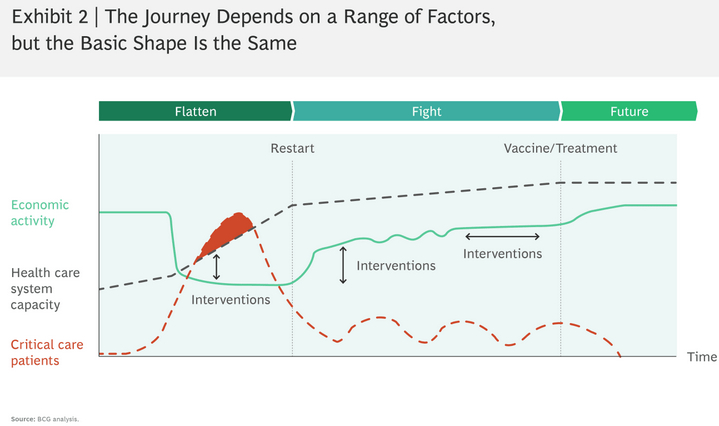The unfolding, global COVID-19 pandemic is a human crisis of historic scale and complexity. It is straining health care systems, government fiscal capacity, and the ability of many organizations to cope with the changes wrought by the virus and the response to it. The level of uncertainty for most leaders is unprecedented, and most of our frameworks for planning and problem solving are unable to manage the geographic variability, uncertainty, and the exponential change brought by the COVID-19 crisis.

In our work to confront this challenge with public and private sector clients worldwide, we have found that many leaders are asking the same set of questions: How should I forecast my revenues? How should I adjust my budget? When will this be over, and when will we return to “normal”? These are good questions, but the reality is, we shouldn’t be asking them at this point. In the wake of so much uncertainty, we should instead focus on framing potential scenarios and use them to develop a robust plan of action.
Three months into the COVID-19 crisis, we are starting to see patterns in its impact on countries and cities, as well as in these areas’ responses. We see three distinct phases. First, there is the “Flatten” phase, in which countries or cities lock down to flatten the virus’s exponential growth curve. Second comes the “Fight” phase, during which a geography “Restarts” its economy while maintaining a low rate of infection, while still running the risk of having to implement further lockdowns. Finally, we are anticipating a “Future” phase, which begins only after a vaccine or highly effective treatment has been developed and deployed.
We have applied this framework on a localized and sector basis and have created different scenarios for each phase to account for the shifting dynamics and complex elements that are part of the COVID-19 landscape.

Three critical insights have emerged from our scenario work:
- Get ready to Restart. The transition from Flatten to Fight, or what we refer to as a “Restart,” is an intentional policy decision that is made when a set of necessary pre-conditions are met in a given geography. Business leaders cannot control that decision or timing, but they can make sure they are ready to Restart.
- The Fight will be protracted. The Fight phase is going to be longer than most leaders we have talked to anticipate. We expect that it will be between 12 to 36 months before a vaccine or highly effective treatment can be developed and deployed.
- The Fight will be expensive. The Fight phase will be more economically challenging than most leaders seem to expect. Because the situation is volatile, consumer and worker confidence has been shaken, and because of the risk of further outbreaks and localized lockdowns, or perhaps even national ones, we envision an ongoing impact to the global economy. Our US-focused scenarios show a potential range of a relatively severe 5% to 20% impact on microeconomic outcomes such as revenues or employment, before accounting for policy interventions and responses, which will strongly influence the end result.
Part of the strategic challenge is that the effects of COVID-19 will vary significantly by geography and sector. Individual companies will see even greater variation amongst their outcomes during each of the Flatten, Fight, and Future phases. Such variation has been observed in every prior economic crisis, and the uncertainty and multi-phase nature of this crisis may lead to greater disparity than usual, creating even more winners and losers than is typical. Accordingly, we think it is imperative for business leaders to use scenarios with a range of outcomes to develop a plan for their companies to: a) Be ready to Restart; b) Win the Fight; and c) Win the Future. Particularly, we think that winning the Fight phase is crucial because it creates the opportunity to win the Future.
To help companies and societies respond to COVID-19, and recover from it, we offer an approach for framing and developing scenarios, and suggest what they can expect in trying to accomplish these goals.

The Complexity of COVID-19 Demands Systematic Scenario Planning
We cannot predict the future. But we can seek to understand what the future might hold, and what that means for nations, industry sectors, and individual companies. We need scenarios to bound the uncertainty, to help us understand the underlying drivers of outcomes, and for some understanding of how we can shape those outcomes.
The data clearly suggests that very different COVID-19 trajectories have played out around the world. (See Exhibit 1.)
AUTHORS: Marin Gjaja , Lars Fæste , Gerry Hansell , and Doug Hohner
MORE: https://www.bcg.com/en-us/publications/2020